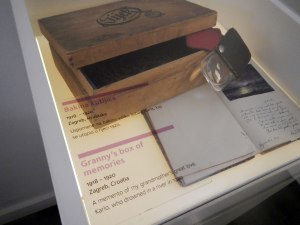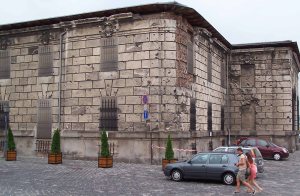
An open-air museum is the best way to describe this small island country and its long and storied history. Add in the strong Greek mythology and devout Greek Orthodox religion, and you have a country that is a true communion with history and religion.
Eleni, our tour guide during the week we were in Cyprus, educated us on numerous aspects of her country, including: nature/natural resources, history and geography, mythology, the tourism industry, the Greek Orthodox religion and the politically charged Cyprus Problem. She was cautious to preface some of her opinions, as just that, but I certainly learned more from her than any history book.
Cyprus is the third largest island in the Mediterranean after Sicily and Sardinia, and is located about 60 miles from Turkey and 72 miles from Syria. The country was formed from a volcano. According to history, earthquakes destroyed almost all of the towns of Cyprus during the fourth century. Its soil is mainly chalk and limestone with sparse vegetation, and the climate mostly hot and arid.
Geographically, Cyprus is divided into three portions: the Troodos Mountains, the Kyrrian Mountain and the Mesari plain, located between the two mountains. The Troodos Mountain range was formed from an earthquake and is mostly solid lava rock.
Cyprus has two natural salt lakes, both of which are dry most of the year, filling up only during the winter rainy period. During the Middle Ages, the salt was mined and exported, as Europe didn’t have salt for some reason. It is no longer mined, according to Eleni, because it is polluted.
 The largest salt lake, near the Larnaca airport, attracts thousands of flamingoes, wild swans and other migrating birds from Asia during the winter months, which then return to Asia in the spring.
The largest salt lake, near the Larnaca airport, attracts thousands of flamingoes, wild swans and other migrating birds from Asia during the winter months, which then return to Asia in the spring.
According to the story of how the salt lake of Larnaca was formed, as told by Eleni, when Lazarus came to the Larnaca area in 32 AD, he was thirsty and hungry. He saw a vineyard of grapes ready for harvest, and asked the vineyard owner, an elderly lady, who was holding a basket full of grapes if he might have some. She refused telling him that the basket was full of salt. Lazarus became very angry and reportedly transformed the vineyard into a salt lake and the basket she was holding into a basket full of salt. People who later worked in the salt lake said they would periodically find roots of the old lady’s vineyard.
 Nearby the lake are the remains of an aqueduct, built in 1745 AD that supplied water to Larnaca and was in use for approximately 200 years.
Nearby the lake are the remains of an aqueduct, built in 1745 AD that supplied water to Larnaca and was in use for approximately 200 years.
Natural Resources/Nature
Copper was discovered during the period between the Stone and Bronze ages. At first the discovery was not well known; however, during the 2500 BC period, word got out, and then the island invasions began in earnest, says Eleni. The Syrians, Egyptians and Persians all invaded Cyprus for its copper. It is believed the island has taken the name from the ‘Cypressus’, the Cyprus trees, and that the island gave the name to copper.
 As you may suspect, olive trees are abundant on the island. According to Eleni, the oldest olive trees in the country are about 700 years old and still producing. She explained the way to recognize an old olive tree is that it has a hollow trunk. Urban legend says you can put a double bed inside an old olive tree trunk.
As you may suspect, olive trees are abundant on the island. According to Eleni, the oldest olive trees in the country are about 700 years old and still producing. She explained the way to recognize an old olive tree is that it has a hollow trunk. Urban legend says you can put a double bed inside an old olive tree trunk.
In addition to olive trees, there are also plenty of carob trees since they do not require much water and grow well in poor soil. Cyprus has about three million carob and olive trees. The carob has the shape of a bean and is black. There are many seeds within the actual plant. “In the past, four seeds of a carob was the standard measure. The carob is used in the plastic industry making cassettes, cosmetics and carob syrup, also known as black honey,” explains Eleni.
Grapes are another important natural resource. Cyprus has about 120 different varieties of grapes that are divided into two categories: table grapes and wine grapes.
Eleni launched into a story about the wine grapes, which she categorized as Very Good. According to her story, “when Richard the Lionhearted came to Cyprus, the inhabitants wanted to welcome him so they offered him a new variety of grapes. They were very delicious. When he tasted them, he announced ‘very good’. But the inhabitants could not speak his language, and they thought he said the name of the variety. Since then, this variety of grape has been known as ‘Very Good’.”
Table grapes grow in the lower elevations with limestone, while the wine grapes grow up in the mountains where there is high rainfall. Because wine grapes ripen longer and become sweeter, workers are paid according to the sweetness of the grapes when they take them to the winery, Eleni stated.
Pine, eucalyptus, mimosa and cypress trees are popular and also plentiful across the island. The British imported Eucalyptus trees to Cyprus from Australia. There are 27 kinds of Eucalyptus documented on the island. This type of tree has the ability to absorb the water from the ground, another reason why they are so popular.
The government has begun reforesting the trees as many had been destroyed. The three reasons for destruction were:
- Cedar trees provided hardwood for building products and home building;
- Trees were cut down for heating homes after the copper discovery; and
- Forests were destroyed by invasions of armies.
A Brief History Lesson
In 323 BC, Alexander the Great liberated Cyprus from the Persians. This was the start of the Hellenistic period. The capital of Cyprus was transferred from Salamis to Paphos, simply because Paphos was the nearest point to Alexandria. Paphos was the capital from the Roman period of 58 BC until the fifth century AD.
During the Byzantine period from the fifth century to 1191 AD, the Archbishop of Cyprus controlled the country. In a vision, he was told that under a carob tree in a Roman tomb in Salamis were the relics of St. Barnabas. He went there, found them, and took them to the archbishop.
During 1191, Richard the Lionhearted was on his way to the Holy Land. One of his boats (carrying his sister and fiancé) mistakenly landed in Cyprus and the occupants, including the two women, were captured. Therefore, Richard the Lionhearted subsequently invaded the island, taking control of it, and released his sister and fiancé.
“But because he really didn’t want to keep Cyprus,” explains Eleni, “he sold the island to the rulers of Jerusalem. Because of the revolutions, they could not keep the island either, and eventually gave it back to Richard.”
In 1489, the last queen of Cyprus – who had a Venetian bloodline – passed the island to the Venetians who ruled from 1499 until 1571. They placed heavy taxes on people and built many fortifications. None of the walls were finished, however, when the Ottomans invaded. The Ottoman Turks then ruled Cyprus until 1878.
From 1879 until 1960, Cyprus was a British colony. In 1960 Cyprus won its independence and has remained so. As part of the agreement, the British bases would remain. According to Eleni, there are about 99 square miles of British bases on the island.
Archbishop Makarios III was elected president in 1960 was making Cyprus the first country with a Christian leader. His vice president was Dr. Fazil Kucuk from the Turkish Muslim community. At the time of Cyprus’ independence, the population was estimated to be 650,000, of which 80 percent were Greek Cypriots, 18 percent Turkish Cypriots and two percent other minorities, such as Armenians, Latins and Maronites.
“The Greek Cypriots speak the Greek language, as do the Christian Orthodox,” explains Eleni. “The Turkish Cypriots speak the Turkish language and are Muslim, but the common language between the two communities is English.”
 The Cyprus Problem
The Cyprus Problem
Soon after the 1960 election, problems began surfacing. In 1963, the Turkish Cypriots left the Parliament. In 1974, Greece tried to assassinate the Cypriot president. “This was the chance Turkey was waiting for,” believes Eleni. “The Turks invaded Cyprus on July 20, 1974 and took control of 40 percent of Cyprus. Two hundred thousand people were forced to leave their homes and came to the central part of the island where the government built them houses. They live with the hope that one day they will go back to their land and homes where they were born. But it’s been 40 years now,” she continues, “and there has been no improvement to the Cyprus Problem. Since 1974, 1,619 people are missing and no one knows what happened to them. So with the solution of the Cyprus Problem, we also hope we will discover what happened to these people, which includes women and children, and whether they are dead or alive.
“When the Turks invaded, Greek and Turkish Cypriots were living harmoniously all across the island. The Turks landed in Kyrenia by boat and the people began fleeing in a panic to save their lives.
 “The Turks bombed the town of Famagusta from the air. When the Turkish Cypriots who fled tried to return to Famagusta, it was impossible because the Turkish troops refused to allow them back. Turkey allowed 140,000 Turkish settlers to settle in Famagusta, giving them property and enticing them to stay on the island. The real Turkish Cypriots were living in poor conditions and many of them were forced to immigrate to other countries. When we say we don’t want the Turks in Cypriot,” emphasizes Eleni, “what we mean are the Turkish troops and the settlers, not the Turkish Cypriots. The Turkish Cypriots are Cypriots. They belong to Cyprus.”
“The Turks bombed the town of Famagusta from the air. When the Turkish Cypriots who fled tried to return to Famagusta, it was impossible because the Turkish troops refused to allow them back. Turkey allowed 140,000 Turkish settlers to settle in Famagusta, giving them property and enticing them to stay on the island. The real Turkish Cypriots were living in poor conditions and many of them were forced to immigrate to other countries. When we say we don’t want the Turks in Cypriot,” emphasizes Eleni, “what we mean are the Turkish troops and the settlers, not the Turkish Cypriots. The Turkish Cypriots are Cypriots. They belong to Cyprus.”
Following the 1974 invasion, it was impossible for the Greek Cypriots to enter the Occupied Area around Famagusta. “If a Turkish Cypriot wanted to come to the west or southern side of the island, there was no problem. This is the reason why we had 8,000 Turkish Cypriots who were passing through coming to work on this side of the island,” reports Eleni. “The Turkish troops would allow them to pass through, but not to stay overnight. For the Greek Cypriots, it was impossible to go to north Cyprus; Turkish troops would not allow them into the Occupied Area.
 “Ten years ago, one day out of the blue, the Turks told the Cypriots that if they wanted to come to this side of the island, they would be allowed in if they brought a passport. You cannot imagine the result!” exclaims Eleni. “Thousands of people came to see the side of the island they had not been allowed in to in 30 years. After 1974 one third of the island population were refugees. The Turkish Cypriots still living in their houses who had not left were overjoyed to see friends and relatives. They invited them in, offering them coffee, and telling them they also wanted a solution to the Cyprus Problem. Settlers who now inhabited the houses shut the doors in the former owners’ faces and would not allow them in to see their old homes.”
“Ten years ago, one day out of the blue, the Turks told the Cypriots that if they wanted to come to this side of the island, they would be allowed in if they brought a passport. You cannot imagine the result!” exclaims Eleni. “Thousands of people came to see the side of the island they had not been allowed in to in 30 years. After 1974 one third of the island population were refugees. The Turkish Cypriots still living in their houses who had not left were overjoyed to see friends and relatives. They invited them in, offering them coffee, and telling them they also wanted a solution to the Cyprus Problem. Settlers who now inhabited the houses shut the doors in the former owners’ faces and would not allow them in to see their old homes.”
Tourism
Cyprus’s economy is heavily based on tourism. About 25 percent of the island workers are in the tourism industry. According to Eleni, today if a Cypriot applied for a tourism job, starting salary would be 700 euro ($800) per month with only one day off a week. And then it is only seasonal. She said that 80 percent of hotels in non-tourist areas close, and if the hotels close, that means restaurants, shops and other stores in the area close as well. That is why Cyprus has such high unemployment from November to May. “It is impossible to find another job because everyone else is looking too. Those who have worked for two consecutive years at the same place can claim unemployment that amounts to approximately 70 percent of their salary for six months and no more,” Eleni states. “If you worked less than two years for a company/shop/restaurant/hotel that closes for the off season, you would need to leave the country and return again for the new tourist season and hope to get your job back or find a new one.”
Last year (2013) Cyprus saw just under $2.5 million from tourism.
Poised among political struggles, early religious strife, the comfort of modern civilization stemming from mythology and ancient ruins, along with the sensory splendor of nature, Cyprus and its historic island culture have something to offer everyone.



 Qin ordered work to begin on the famous mausoleum soon after he became king. Historians believe it took 700,000 men and 38 years to construct the mausoleum, which was larger than any city of the world at that time. His burial chamber was to be enclosed within the structure.
Qin ordered work to begin on the famous mausoleum soon after he became king. Historians believe it took 700,000 men and 38 years to construct the mausoleum, which was larger than any city of the world at that time. His burial chamber was to be enclosed within the structure.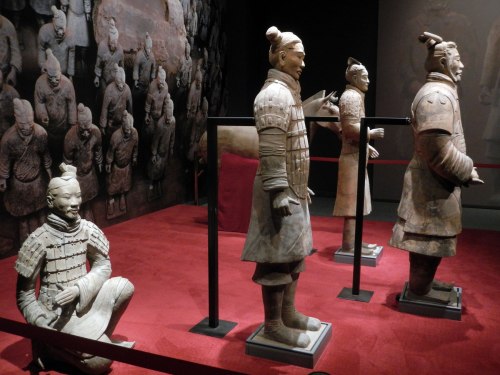
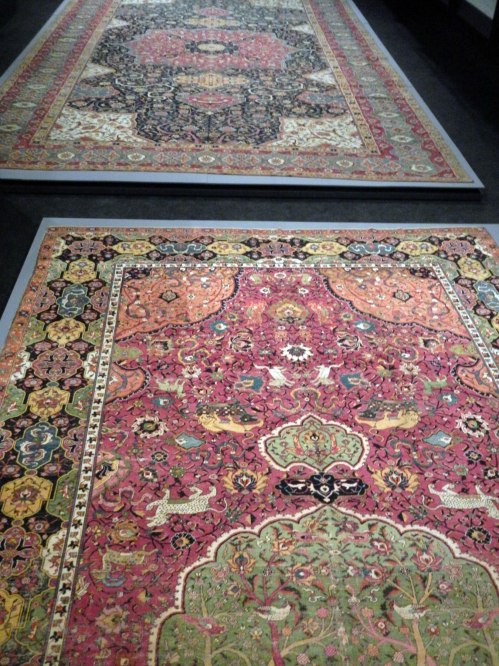 The artistic collection and interwoven connection of these dynasties – Ottoman, Safavid and Mughal – are highlighted through their handmade rugs, motif tiles, manuscripts and ceramics primarily from the 16th to the 18th centuries. It was commonplace for these empires to exchange artistic and material treasures – and cultures – whether as diplomatic gifts or objects of warfare.
The artistic collection and interwoven connection of these dynasties – Ottoman, Safavid and Mughal – are highlighted through their handmade rugs, motif tiles, manuscripts and ceramics primarily from the 16th to the 18th centuries. It was commonplace for these empires to exchange artistic and material treasures – and cultures – whether as diplomatic gifts or objects of warfare.

 figural. Artist Shad Quli, head of Sulayman the Magnificent studio workshop, introduced this motif and became well known for his drawings that combined a stylized leaf with dragons.
figural. Artist Shad Quli, head of Sulayman the Magnificent studio workshop, introduced this motif and became well known for his drawings that combined a stylized leaf with dragons.
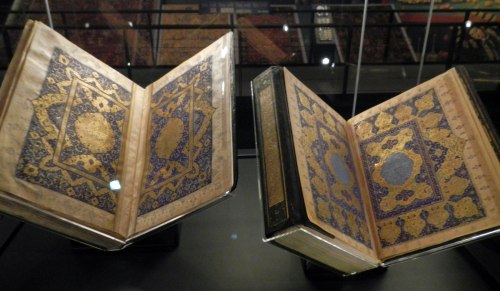
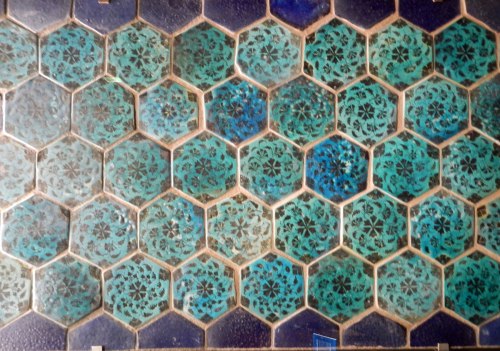


 One of the important artistic styles coming out of this time period was detailed floral designs that were prominent in carpets and jewelry. On display is a silk and pashmina pile carpet that features millefleurs, distinguished by their floral motifs and vivid colors. The carpet design clearly shows a flowering vase at the base and is an early 18th century product.
One of the important artistic styles coming out of this time period was detailed floral designs that were prominent in carpets and jewelry. On display is a silk and pashmina pile carpet that features millefleurs, distinguished by their floral motifs and vivid colors. The carpet design clearly shows a flowering vase at the base and is an early 18th century product.

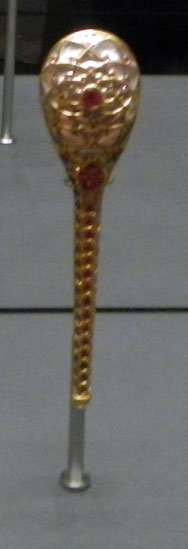
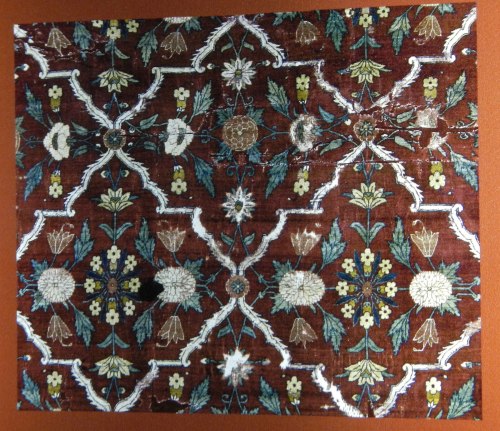








 Radwani bought the courtyard house, originally constructed in the 1920s, in 1936. The family abandoned the home in 1971 and it sat vacant and derelict until 2007.
Radwani bought the courtyard house, originally constructed in the 1920s, in 1936. The family abandoned the home in 1971 and it sat vacant and derelict until 2007.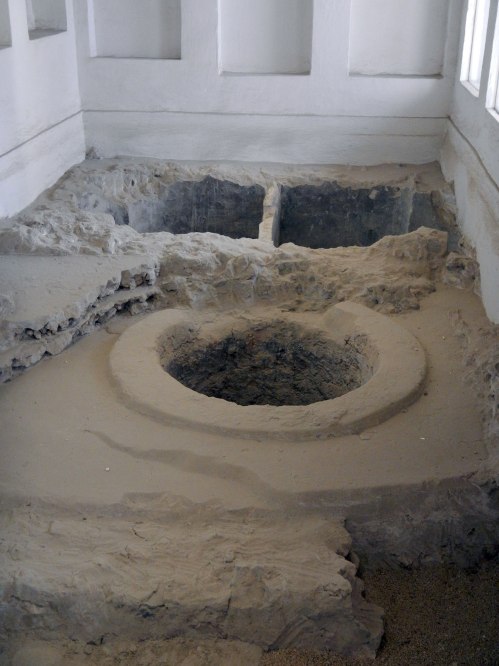
 The Company House, the former headquarters of the Anglo-Persian Oil Company, is devoted to the history of Qatar’s petroleum industry. It features various tools and appliances from the early days of the oil industry in 1939, firsthand accounts of the grueling labor by pioneering workers, and six white life-sized plaster statues showing the different jobs these men performed during the mid 20th century.
The Company House, the former headquarters of the Anglo-Persian Oil Company, is devoted to the history of Qatar’s petroleum industry. It features various tools and appliances from the early days of the oil industry in 1939, firsthand accounts of the grueling labor by pioneering workers, and six white life-sized plaster statues showing the different jobs these men performed during the mid 20th century.
 The most interesting house, in my opinion, is the Bin Jelmood House, named for a renowned Qatari slave owner, which features the history of slavery in Qatar, an overview of historical slavery stemming from the Indian Ocean region, and contemporary slavery – human trafficking – around the world. The historical accounts and firsthand testimonials of Qatar slaves are powerful and relevant. Despite a shameful legacy, it was refreshing to see that Qatar did not sugarcoat slavery in this country. It was a very detailed and informative museum house that encourages discussion of historical slavery in the country, as well as modern day slavery worldwide.
The most interesting house, in my opinion, is the Bin Jelmood House, named for a renowned Qatari slave owner, which features the history of slavery in Qatar, an overview of historical slavery stemming from the Indian Ocean region, and contemporary slavery – human trafficking – around the world. The historical accounts and firsthand testimonials of Qatar slaves are powerful and relevant. Despite a shameful legacy, it was refreshing to see that Qatar did not sugarcoat slavery in this country. It was a very detailed and informative museum house that encourages discussion of historical slavery in the country, as well as modern day slavery worldwide. As stated at the renovated house entrance: “Bin Jelmood House exists to promote reflection and conversation on important truths about historical slavery in Qatar and the critical issue of contemporary slavery around the world.”
As stated at the renovated house entrance: “Bin Jelmood House exists to promote reflection and conversation on important truths about historical slavery in Qatar and the critical issue of contemporary slavery around the world.”




 A gentle waterfall spilling into the basin within the old village offers melodic serenity and natural beauty. The village was built on the banks of two rivers, which join in the center of the 1500-inhabitant 14th Century village. A hike to the top of the village provides the most beautiful vista of the surrounding landscape as far as one can see. In fact, on a clear day the sea is visible off in the distance.
A gentle waterfall spilling into the basin within the old village offers melodic serenity and natural beauty. The village was built on the banks of two rivers, which join in the center of the 1500-inhabitant 14th Century village. A hike to the top of the village provides the most beautiful vista of the surrounding landscape as far as one can see. In fact, on a clear day the sea is visible off in the distance.




 The largest salt lake, near the Larnaca airport, attracts thousands of flamingoes, wild swans and other migrating birds from Asia during the winter months, which then return to Asia in the spring.
The largest salt lake, near the Larnaca airport, attracts thousands of flamingoes, wild swans and other migrating birds from Asia during the winter months, which then return to Asia in the spring. Nearby the lake are the remains of an aqueduct, built in 1745 AD that supplied water to Larnaca and was in use for approximately 200 years.
Nearby the lake are the remains of an aqueduct, built in 1745 AD that supplied water to Larnaca and was in use for approximately 200 years. As you may suspect, olive trees are abundant on the island. According to Eleni, the oldest olive trees in the country are about 700 years old and still producing. She explained the way to recognize an old olive tree is that it has a hollow trunk. Urban legend says you can put a double bed inside an old olive tree trunk.
As you may suspect, olive trees are abundant on the island. According to Eleni, the oldest olive trees in the country are about 700 years old and still producing. She explained the way to recognize an old olive tree is that it has a hollow trunk. Urban legend says you can put a double bed inside an old olive tree trunk. The Cyprus Problem
The Cyprus Problem “The Turks bombed the town of Famagusta from the air. When the Turkish Cypriots who fled tried to return to Famagusta, it was impossible because the Turkish troops refused to allow them back. Turkey allowed 140,000 Turkish settlers to settle in Famagusta, giving them property and enticing them to stay on the island. The real Turkish Cypriots were living in poor conditions and many of them were forced to immigrate to other countries. When we say we don’t want the Turks in Cypriot,” emphasizes Eleni, “what we mean are the Turkish troops and the settlers, not the Turkish Cypriots. The Turkish Cypriots are Cypriots. They belong to Cyprus.”
“The Turks bombed the town of Famagusta from the air. When the Turkish Cypriots who fled tried to return to Famagusta, it was impossible because the Turkish troops refused to allow them back. Turkey allowed 140,000 Turkish settlers to settle in Famagusta, giving them property and enticing them to stay on the island. The real Turkish Cypriots were living in poor conditions and many of them were forced to immigrate to other countries. When we say we don’t want the Turks in Cypriot,” emphasizes Eleni, “what we mean are the Turkish troops and the settlers, not the Turkish Cypriots. The Turkish Cypriots are Cypriots. They belong to Cyprus.” “Ten years ago, one day out of the blue, the Turks told the Cypriots that if they wanted to come to this side of the island, they would be allowed in if they brought a passport. You cannot imagine the result!” exclaims Eleni. “Thousands of people came to see the side of the island they had not been allowed in to in 30 years. After 1974 one third of the island population were refugees. The Turkish Cypriots still living in their houses who had not left were overjoyed to see friends and relatives. They invited them in, offering them coffee, and telling them they also wanted a solution to the Cyprus Problem. Settlers who now inhabited the houses shut the doors in the former owners’ faces and would not allow them in to see their old homes.”
“Ten years ago, one day out of the blue, the Turks told the Cypriots that if they wanted to come to this side of the island, they would be allowed in if they brought a passport. You cannot imagine the result!” exclaims Eleni. “Thousands of people came to see the side of the island they had not been allowed in to in 30 years. After 1974 one third of the island population were refugees. The Turkish Cypriots still living in their houses who had not left were overjoyed to see friends and relatives. They invited them in, offering them coffee, and telling them they also wanted a solution to the Cyprus Problem. Settlers who now inhabited the houses shut the doors in the former owners’ faces and would not allow them in to see their old homes.”
